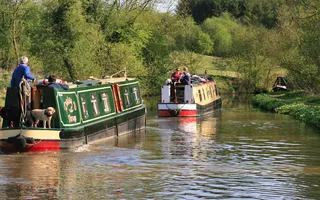Casting off
- Start the engine, keep it in neutral and allow time for it to warm up before you move.
- Untie the front and back mooring ropes from the bank, but leave them tied to the boat, coiled and ready for use.
- On rivers, untie the downstream rope first. Make sure your ropes can't trail in the water and get caught in the propeller. Don't forget to stow the mooring stakes and hammer.
- Because boats steer from the back, you can't drive away from the bank as in a car. Check the surrounding water is clear of traffic, then push the boat away from the bank to allow your propeller to start up in deeper water.
- In shallow water, push the back of the boat out, then reverse away until there's room to straighten up. When the boat's straight, go into forward gear and accelerate gently to cruising speed.
Driving your boat
- On all waterways, you must drive on the right.
- As most canals are fairly narrow, you'll probably steer down the middle (until you meet oncoming craft) as it's likely to be shallow near the edges.
- Don't cut the corner when going around bends. You run the risk of a collision or going aground.
Steering your boat
- Most boats pivot from a point about halfway along their length, so watch out for the front and the back. If you only line up the front and then try to turn into a narrow gap (e.g a bridge or lock), you risk hitting the side with the back of your boat.
- Watch out for any currents or crosswinds pushing you off course.
Boats with steering wheels
- Steering a boat with a wheel is like steering a car, but it's more difficult to judge where your wheel should be for going straight ahead.
- Get to know the feel of the wheel and the rudder position before you set off.
Boats with tillers
- Remember that pushing a tiller to the right will make the boat head left and vice versa.
- Be patient and plan ahead – the boat will take a few seconds to respond.
- You have less steerage at very low power. The boat will respond more quickly to the tiller when the propeller is turning more quickly.
How to pass other boats
- Go slowly past other waterway users.
- When you meet an approaching boat, keep to the right and pass 'port-to-port' (the left side of your boat passes the left side of the other boat).
- Don't let your boat create a breaking wave or a lowering of the water along the bank just ahead of the boat. These are signs that you should throttle back to prevent damage to the bank and disturbance to moored boats. Excessive speed can also dislodge mooring pins.






